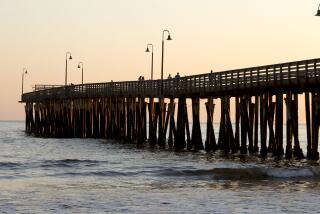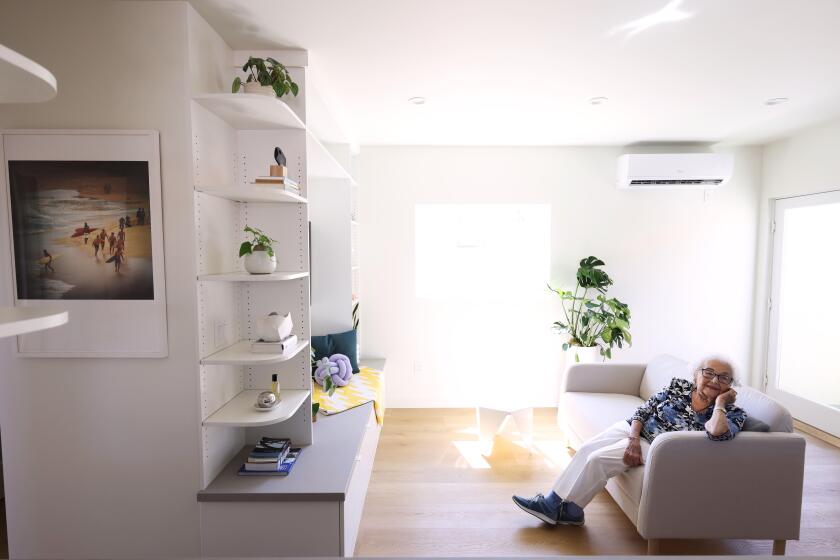San Diego Hopes for Suite Success at Historic Hotel
SAN DIEGO — For decades, it was the crown jewel of San Diego, sitting serenely atop a steep hill and providing a panoramic view from the mountains of Mexico to the ocean off Point Loma.
The Sky Room lounge was the scene of many a romantic interlude, the winking neon stars on the building’s exterior were a beacon in the night sky, and the outside glass elevator (the first of its kind in the nation) was a tourist attraction to rival the celebrated San Diego Zoo.
Generations of wedding receptions, business meetings and political rallies were held at the El Cortez Hotel. Built in 1927 for the then-astounding sum of $2 million, the El Cortez was meant to bring big-city sophistication and glamour to what at the time was still an isolated and homespun Navy outpost.
With its Saxony carpets, massive beamed ceilings and lush tapestries, the El Cortez was considered the equal of other luxury hotels of its era, the Roosevelt in Hollywood, the Pontchartrain in New Orleans and even the Ritz-Carlton in Boston. The same architect designed the El Cortez and the Mark Hopkins in San Francisco and the two share motifs.
“The El Cortez was the choice location in San Diego for important events and special evenings,” said Alan Ziegaus, former journalist and onetime member of the county Planning Commission. “When something was really important, it happened at the El Cortez.”
But that was then and this is now, and for much of the last 20 years the once glorious hotel has been a boarded-up eyesore. Much of the rest of San Diego’s downtown has enjoyed a renaissance, but the El Cortez has festered.
A succession of owners promised to restore the El Cortez to its prime, only to have those plans dashed by political indecision and a harsh recession. Always worried about San Diego’s public image, city officials are embarrassed that the first glimpse airline passengers get of downtown San Diego is the deteriorating hulk that the El Cortez has become.
Now, however, there is new hope.
Two partners who have renovated historic buildings in Long Beach and Denver are promising to restore the 16-story structure to its splendor. Even planning officials who have seen other plans dashed are optimistic.
“I’m keeping my fingers crossed because I’ve been down this aisle before and been disappointed,” said Pam Hamilton, a top official with the city redevelopment agency. “But this time, I think it’s really going to happen.”
The city’s redevelopment agency has provided a loan of $5.85 million, the largest rehabilitation loan granted in San Diego. The developers are seeking to leverage the loan into private financing, with the total renovation hovering near $20 million.
Plans call for the hotel to be returned to its classic 1927 appearance, a 310-foot building on a 175-foot hill. Features added in the 1950s--an industrial-looking seven-story annex, the glass elevator, the upswept, batwing roof on the Starlight Room--will not be retained. Alas, neither will the Sky Room lounge.
In its heyday, the big building at 7th and Ash streets with its Spanish Renaissance design and ornate exterior reigned supreme as the city’s tallest building, the focal point of its social life, and proof positive of the boosterish prediction that San Diego was designed for greatness.
*
The El Cortez was the hotel for celebrities and homesick sailors, traveling dignitaries and teenagers on their first grown-up date. The El Cortez saw many a first drink, first date and first love.
Elvis Presley, Bing Crosby and Roy Rogers adored the El Cortez. Presidents Eisenhower, Johnson and Ford visited the El Cortez. Ike was miffed that his suite was smaller than Elvis’.
“Every serviceman who was ever stationed in San Diego has a romantic memory of going to the El Cortez with his beloved,” said former city architect Mike Stepner, who stayed at the El Cortez with his wife after she joined him in San Diego during his Navy hitch. “The El Cortez was a place of wonder.”
San Diegans were protective of their super-fancy hotel. The newspapers were reverential in their coverage. The comings and goings of visitors and management personnel at the El Cortez (and the city’s other venerable hotel, the U.S. Grant) were dutifully noted.
In the first panicky hours after the Japanese attack on Pearl Harbor, 100 U.S. Marines with fixed bayonets were ordered to stand guard around the El Cortez. San Diegans were convinced that if the Japanese invaded, their first objective would be to conquer San Diego’s pride and joy and occupy its commanding location.
Navy admirals moved into the El Cortez for safety. An antiaircraft battery was installed on the hotel roof. Local lore holds that while buildings during World War II were ordered to observe nighttime blackouts, the El Cortez was frequently asked to turn on its lights so Navy pilots lost in the fog could find their way to a friendly flight pattern.
By the early 1970s, the El Cortez was beginning to lose popularity. New hotels were popping up and the public taste for opulence in dining and dancing was on the wane.
In a move that still causes considerable grumbling, the El Cortez--unlike the Hotel del Coronado across San Diego Bay--went downscale and began, as one San Diegan noted, to offer “prime rib dinners, two for $5.98, that kind of thing.”
In 1978, the Handlery family, local hoteliers who had bought the El Cortez in 1951 from the original owner, developer Richard Robinson Jr., sold the hotel to Morris Cerullo’s World Evangelism movement. Cerullo, who spread his message on television, had dreams of making San Diego the center of his religious movement and attracting thousands of acolytes to a “spiritual boot camp.”
The conversion of the once saucy and high-living hotel into a religious center was not without shock value.
The Starlight Room on the 12th floor, where couples once would dance and romance into the wee hours, was converted into a chapel; the Sky Room on the 15th floor, where many a cocktail had been downed, became a prayer center. The neon stars on the outside of the building no longer sparkled.
By 1981, Cerullo’s San Diego dream had died, and he moved his operations to Memphis, Tenn. He sold the hotel to a local developer and its history of disappointment and deterioration had begun. Each passing year seemed to bring a new plan to revive the El Cortez.
*
A Japanese real estate firm had plans. The Bass brothers of Texas and Philadelphia had plans. At various times, plans were announced to turn the El Cortez into a convention center, a courthouse, a retirement home, an Art Deco hotel, and part of a multi-block residential and commercial development.
Vandals and taggers struck repeatedly. The El Cortez was dying by inches. Its plight occasioned many a lament and many a hand-wringing newspaper editorial.
“The El Cortez was a bright star whose light went out far too soon,” said Ziegaus. “It’s been very sad.”
For partners Anthony Block and Peter Janopaul III --whose renovation projects include the Kress Building in Long Beach--one look at the El Cortez was enough. They began negotiations to buy the building and moved their firm from Long Beach to San Diego.
“When I saw it, I wanted to rescue it immediately,” Block said. “It’s this great, old, wonderful structure that needs help. There’s really nothing like it left in San Diego. San Diego has a habit of tearing things down.”
Renovation projects require lots of money and a maze of bureaucratic permits. When the building is as old as the El Cortez, the difficulties are daunting.
Still, Janopaul knew things were going well when an important San Diego civic figure--whom he declines to identify--told him, sotto voce: “I have a strong affinity for this building. I attended my senior prom there, and boy did we get loaded in the glass elevator!”
Block and Janopaul envision 76 apartments, seven lofts, four full-floor suites and one two-level penthouse. Also, a restaurant, a cafe, a ballroom and elegant street-level shops.
Talking last week to a local planning group, Janopaul said construction would take 11 months, but he declined to say when it will begin. Final details on financing and historic building tax credits need to be ironed out.
But Janopaul said groups have already contacted him about booking the ballroom for civic gatherings. An appeal by the partners for stories and pictures about the hotel in happier days has spurred a tidal wave of nostalgia about parties and celebrations and liaisons dangereuses.
“It seems like everybody in San Diego has a memory of the El Cortez,” Janopaul said.
More to Read
Sign up for The Wild
We’ll help you find the best places to hike, bike and run, as well as the perfect silent spots for meditation and yoga.
You may occasionally receive promotional content from the Los Angeles Times.






